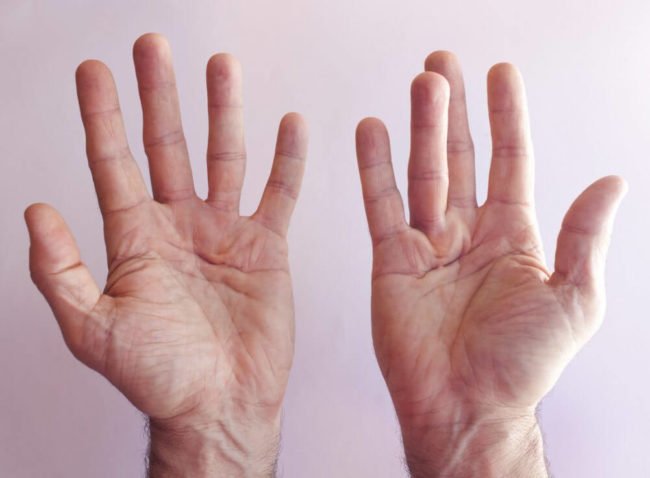Is Dupuytren’s contracture painful in some instances? Find out what can be done about it.
Have you ever noticed small, tender bumps in the fleshy part of your palms?
Those lumps could be a sign of Dupuytren’s contracture (DC), a condition in the hands that can result in limited functioning or your muscles. And, in some cases, can cause pain.
It’s important to learn everything you can about this condition to be able to prevent it and/or treat it. You may only have the beginning symptoms, but now is the most important time to understand what’s going on in your hands.
To learn how to treat your dupuytren contracture, keep reading.
What is Dupuytren’s Contracture?
Our hands have fibrous bands that stretch from your palm to the ends of your fingers. These bands are flexible and elastic when they’re healthy.
When someone has DC, those bands of tissue develop lumps that eventually cause the tissue to grow thicker. Those lumps can sometimes feel sore or tender, or not feel like anything at all. However, they are an indication of onset DC.
As the tissue becomes thicker, it contracts the bands that connect to your fingers causing them to curl inwards.
In severe cases, it causes hand deformity and loss of mobility in the hands.
What Causes It?
There hasn’t been a direct cause discovered for Dupuytren’s contracture yet. We do know that it isn’t caused by overuse of the hands or from an injury.
Research has shown that it is more common in men than women, especially men over the age of 50.
It’s also been proven to be hereditary; people of Northern Europe descent are more likely to have Dupuytren’s contracture.
As with many health conditions, the risk factors include smoking, alcohol consumption, and diabetes. It’s also been known to exist alongside other hand conditions like arthritis.
Symptoms
The first sign of DC is noticing 1-2 small lumps that develop in the palm of your hand. These lumps might be tender, or they may not be sensitive at all.
Your pinky and ring fingers are more commonly affected than your thumb, index, and middle fingers. You may notice some stiffness in these fingers.
It’s important you see a doctor as soon as you notice these lumps in your hands. Dupuytren’s contracture usually develops slowly over multiple years; monitoring it from the beginning will help doctors know what kind of treatment will work for you.
Is Dupuytren’s Contracture Painful?
There’s been some controversy over whether DC is a painful condition. For most patients, it is not painful. Your hands may feel stiff, tender, or uncomfortable.
In the minority of cases, there is pain present in the hands. The lumps can sometimes be very sensitive and sore. What we know from research is that if you experience pain at the onset of the condition, along with itchiness, that may be an indication that it is a more aggressive form of DC.
When to See a Doctor
You should see your family doctor as soon as you notice any lumps in your palms. They will likely do an exam on your hands to accurately diagnose the lumps and determine a solution.
The exam consists of your doctor checking the mobility of your hands, wrists, and fingers. They will feel the lumps and record how many. They may ask you to place your palm on the table to see if your hand can lay flat or ask you to pick up small items only using your thumb and a finger in a pinching motion.
These exams will need to happen regularly since this condition develops over many years.
Knowing your baseline exam records will help doctors see how fast the condition is developing; recording your symptoms can help dictate which method of treatment you use.
Treatment
Unfortunately, there is no cure for dupuytren contracture.
Even with the best treatments, there’s always a chance it could return. Luckily, it isn’t a life-threatening condition and many patients continue to lead full and happy lives with it.
There are a few different treatments available as well as preventative techniques. We’ll address each method in detail, so you can make a more informed decision, along with your doctor, on which one is right for you.
1. Preventative Measures
If you have a familial history of developing dupuytren contracture, it’s wise to go the extra mile with your hand health.
Stretching
Conservative stretching is a great way to maintain the flexibility in your hand’s fibrous bands. DC causes these bands to lose their elasticity, so stretching can help prolong or prevent the onset.
Start by gently bending the hand backward at the wrist to stretch out the bottom of your palm. Then, bend each finger backward to gently stretch the bands that connect the fingers to the palm. Bend the hand forward at the wrist to stretch the back of your hand.
Another beneficial stretch is to place your hand as flat as possible on a table, then lift up the palm while your fingertips remain on the surface. This feels wonderful on your finger tissues as well as your palm.
Massage
Whenever you notice soreness or stiffness in your hands, it can be soothing to give yourself a hand massage. Using anti-inflammatory creams, or lanolin ointment can reduce the tenderness.
Try using the thumb of your opposite hand to massage your palm and roll out any tension or stiffness. Massage the tendon upwards and downwards along the fingers.
In addition to stretching and massaging, avoid using a tight grip to lift anything unless it has cushion tape. Anytime you must do a task that requires gripping, consider using heavily padded gloves.
2. Medication
Your doctor might want to start treating your dupuytren contracture with medication since it’s less invasive than surgery. As mentioned above, there is no cure for DC, but these medications can greatly improve your condition.
Corticosteroid
One type of medication is a corticosteroid injection. This is an anti-inflammatory agent which will reduce the swelling and tenderness in your hands.
Although it does an excellent job of reducing any pain, it cannot reverse the contraction that has already occurred. However, it may prevent future contraction.
Collagenase
Another injection your doctor might choose is a collagenase injection. This medicine is made up of enzymes that dissolve the thickened tissue by weakening the tight bands.
Although it is a beneficial treatment, it can cause swelling, bleeding, and bruising in your hands.
With any type of injection, you may feel pain at the injection site. Some doctors will offer a topical anesthetic for patients who can’t tolerate pain from needles.
3. Traditional Dupuytren Contracture Surgery
If you’ve tried medicinal treatments and they didn’t improve your condition, it may be time to consider surgery.
The traditional, and most invasive, surgery for DC requires the surgeon to create an open incision and cut off the excess thick tissue in your palms. Patients can be put under anesthesia for this process.
As with any surgery, this one also comes with some risks: infection in the incision, damage to the nerves, and even potentially permanent finger stiffness. You should weigh the risks against the benefits to see if this treatment option is worth it to you.
Most patients fully recover after several months post-surgery and endure some swelling and stiffness after the procedure. Unfortunately, research has stated that the condition recurrence rate is 20% of people who have this surgery.
Physical therapy is usually required after surgery to help heal the hands and get them accustomed to broader functioning.
4. Aponeurotomy
This is another type of surgery that is less invasive than the traditional procedure, sometimes referred to as needling.
A specialized hand surgeon will use sharp needles to penetrate through the skin and cut loose the tight bands in your palms. There is no open incision, so the recovery process is faster than the traditional procedure.
Although it’s less invasive, it is also less effective when used to treat DC on its own. In conjunction with corticosteroid injections and self-massage, the outlook is much more successful.
5. Radiation
Another option for less invasive treatment is radiation therapy. Using low energy, the radiation can help reduce symptoms or halt them before they get worse. This often involves treating the lumps or nodules, and the bands in your hands.
Although this is an option for dupuytren contracture treatment, it hasn’t been studied nearly as much as the previous four options.
Interested in Learning More?
The hands are vulnerable to a variety of conditions besides dupuytren contracture.
Since your hands require the optimal functioning of so many different parts (muscles, nerves, bands, nails, etc.) it’s best to always be aware of any potential symptoms you may be experiencing.
Never be afraid to ask your doctor to look into what you’re experiencing, it could be the difference between having healthy hands and potentially losing function of them.
If you’d like to learn more about our services or have questions about possible treatment options, call us today!





















